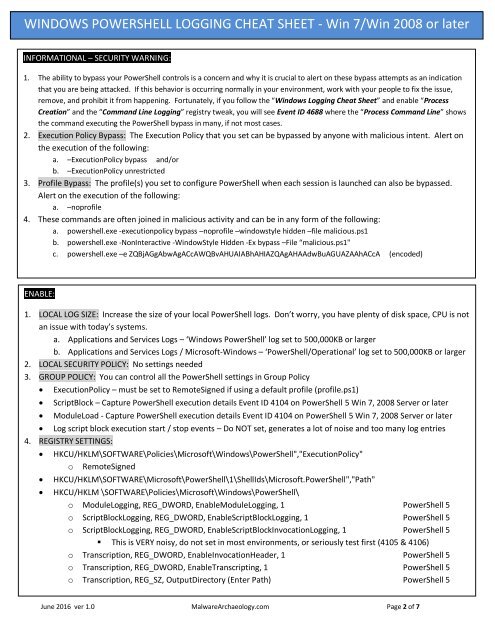Windows+PowerShell+Logging+Cheat+Sheet+ver+June+2016+v2
Windows+PowerShell+Logging+Cheat+Sheet+ver+June+2016+v2
Windows+PowerShell+Logging+Cheat+Sheet+ver+June+2016+v2
Create successful ePaper yourself
Turn your PDF publications into a flip-book with our unique Google optimized e-Paper software.
WINDOWS POWERSHELL LOGGING CHEAT SHEET - Win 7/Win 2008 or later<br />
INFORMATIONAL – SECURITY WARNING:<br />
1. The ability to bypass your PowerShell controls is a concern and why it is crucial to alert on these bypass attempts as an indication<br />
that you are being attacked. If this behavior is occurring normally in your environment, work with your people to fix the issue,<br />
remove, and prohibit it from happening. Fortunately, if you follow the “Windows Logging Cheat Sheet” and enable “Process<br />
Creation” and the “Command Line Logging” registry tweak, you will see Event ID 4688 where the “Process Command Line” shows<br />
the command executing the PowerShell bypass in many, if not most cases.<br />
2. Execution Policy Bypass: The Execution Policy that you set can be bypassed by anyone with malicious intent. Alert on<br />
the execution of the following:<br />
a. –ExecutionPolicy bypass and/or<br />
b. –ExecutionPolicy unrestricted<br />
3. Profile Bypass: The profile(s) you set to configure PowerShell when each session is launched can also be bypassed.<br />
Alert on the execution of the following:<br />
a. –noprofile<br />
4. These commands are often joined in malicious activity and can be in any form of the following:<br />
a. powershell.exe -executionpolicy bypass –noprofile –windowstyle hidden –file malicious.ps1<br />
b. powershell.exe -NonInteractive -WindowStyle Hidden -Ex bypass –File “malicious.ps1"<br />
c. powershell.exe –e ZQBjAGgAbwAgACcAWQBvAHUAIABhAHIAZQAgAHAAdwBuAGUAZAAhACcA (encoded)<br />
ENABLE::<br />
1. LOCAL LOG SIZE: Increase the size of your local PowerShell logs. Don’t worry, you have plenty of disk space, CPU is not<br />
an issue with today’s systems.<br />
a. Applications and Services Logs – ‘Windows PowerShell’ log set to 500,000KB or larger<br />
b. Applications and Services Logs / Microsoft-Windows – ‘PowerShell/Operational’ log set to 500,000KB or larger<br />
2. LOCAL SECURITY POLICY: No settings needed<br />
3. GROUP POLICY: You can control all the PowerShell settings in Group Policy<br />
ExecutionPolicy – must be set to RemoteSigned if using a default profile (profile.ps1)<br />
<br />
ScriptBlock – Capture PowerShell execution details Event ID 4104 on PowerShell 5 Win 7, 2008 Server or later<br />
ModuleLoad - Capture PowerShell execution details Event ID 4104 on PowerShell 5 Win 7, 2008 Server or later<br />
Log script block execution start / stop events – Do NOT set, generates a lot of noise and too many log entries<br />
4. REGISTRY SETTINGS:<br />
<br />
<br />
<br />
HKCU/HKLM\SOFTWARE\Policies\Microsoft\Windows\PowerShell","ExecutionPolicy"<br />
o RemoteSigned<br />
HKCU/HKLM\SOFTWARE\Microsoft\PowerShell\1\ShellIds\Microsoft.PowerShell","Path"<br />
HKCU/HKLM \SOFTWARE\Policies\Microsoft\Windows\PowerShell\<br />
o ModuleLogging, REG_DWORD, EnableModuleLogging, 1 PowerShell 5<br />
o ScriptBlockLogging, REG_DWORD, EnableScriptBlockLogging, 1 PowerShell 5<br />
o ScriptBlockLogging, REG_DWORD, EnableScriptBlockInvocationLogging, 1 PowerShell 5<br />
• This is VERY noisy, do not set in most environments, or seriously test first (4105 & 4106)<br />
o Transcription, REG_DWORD, EnableInvocationHeader, 1 PowerShell 5<br />
o Transcription, REG_DWORD, EnableTranscripting, 1 PowerShell 5<br />
o Transcription, REG_SZ, OutputDirectory (Enter Path) PowerShell 5<br />
June 2016 ver 1.0 MalwareArchaeology.com Page 2 of 7



